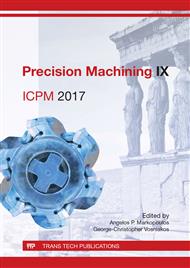[1]
C. Nizankowski Centuria, Columbia, Altos and Aulos. Proceedings Rolling bearings and Manufacturing 2002, University of Žilina, Súlov, Slovakia (2002), 68-73.
Google Scholar
[2]
J. Webster, M. Tricard Innovations in Abrasive Products for Precision Grinding. CIRP Annals-Manufacturing Technology, Vol. 53, Issue 2, (2004), 597-617.
DOI: 10.1016/s0007-8506(07)60031-6
Google Scholar
[3]
T. Nguyen, L. Zhang The coolant penetration in grinding with segmented wheels – part 1: mechanism and comparison with conventional wheels. International Journal of Machine Tool & Manufacture, vol. 45 (2005), 1412-1420.
DOI: 10.1016/j.ijmachtools.2005.01.035
Google Scholar
[4]
O. Bilek, J. Hrdina, I. Lukovics, R. Pero, D. Samek Improved shape of rotating grinding wheels for high speed grinding. Tehnicki Vjesnik, (2014), Vol. 21, No. 1, 63–68.
Google Scholar
[5]
M. Marinescu, B. Hitchiner, W.B. Rowe, I. Inasaki Handbook of Machining with Grinding Wheels, New York, CRC Press (2007).
DOI: 10.1201/b19462
Google Scholar
[6]
T. Tawakoli High efficiency deep grinding. Mechanical Engineering Publication Limited(1993).
Google Scholar
[7]
H. Tonshoff, T. Friemuth, J. Becker Continuous Path Controlled Grinding of Crankshafts, Abrazive Magazine, 12/01, (2000), 25-29.
Google Scholar
[8]
Y. Ichida, K. Kishi The development of nano-crystalline cBN for enhanced superalloy grinding performance. Journal of Manufacturing Science and Engineering, (1995), ASME, vol. 115, 349-361.
Google Scholar
[9]
Z. Prusak, J. Webster Preparation of Hybrid cBN/Seeded Gel Wheels for Precision Grinding. Proceedings of International Machining and Grinding Conference (1995), Michigan, USA.
DOI: 10.1080/002075497194507
Google Scholar
[10]
Y. Zhao, D. He, J. Qian, L. Daemen, J. Huang Novel Superhard Materials to Rival Diamond. Proceedings Intertech, Vancouver (2003).
Google Scholar
[11]
Aurich, P. Herzenstiel, H. Sudermann, T. Magg High-performance dry grinding using grinding sheel with a defined grain pattern. CIRP Annals, Manufacturing Technology (2008), vol. 57, 357-362.
DOI: 10.1016/j.cirp.2008.03.093
Google Scholar
[12]
S. Shaji Solid Lubricant Impregnated Wheel. International Journal of Machine Tool Manufacture (2003), vol. 43, 965 – 972.
Google Scholar
[13]
T. Tanaka, Y. Isono New development of a grinding wheel with resin cured by ultraviolet light. Journal of Material Processing Technology, vol. 113 (2001), 385-391.
DOI: 10.1016/s0924-0136(01)00636-7
Google Scholar
[14]
M. Wu Method for Making High Permeability Grinding Wheels. Norton Company (1998), US Patent 5, 738 696.
Google Scholar
[15]
R. Čep, A. Janásek, J. Petru, M. Sadilek, P. Mohyla, J. Valicek, M. Harnicarova, A. Czan Surface roughness after machining and influence of feed rate on process. Key Engineering Materials, TTP Zurich, Vol. 581, (2014), No. 1, 341-347.
DOI: 10.4028/www.scientific.net/kem.581.341
Google Scholar


